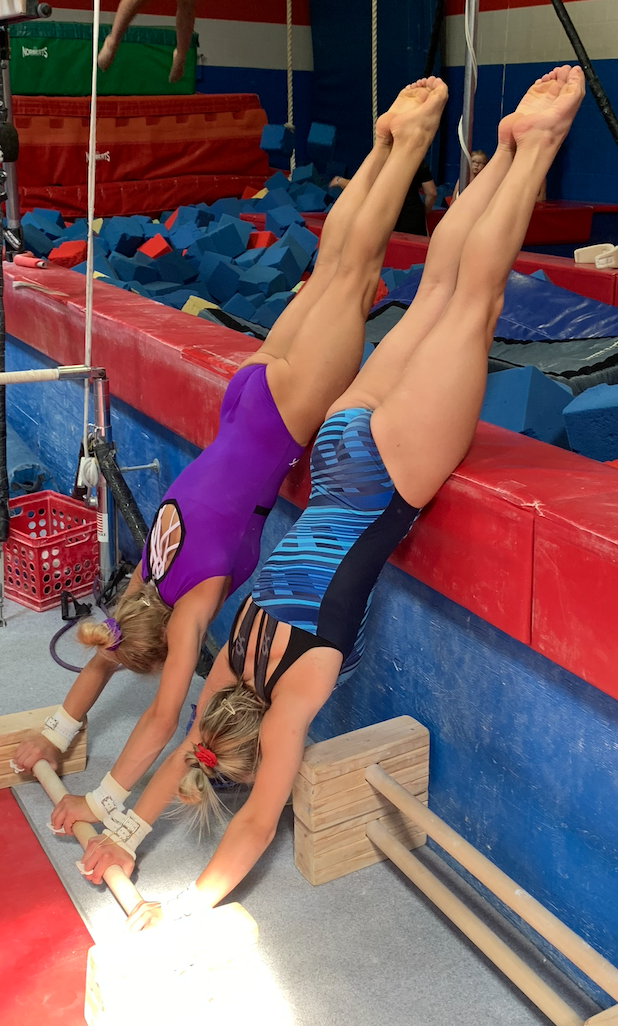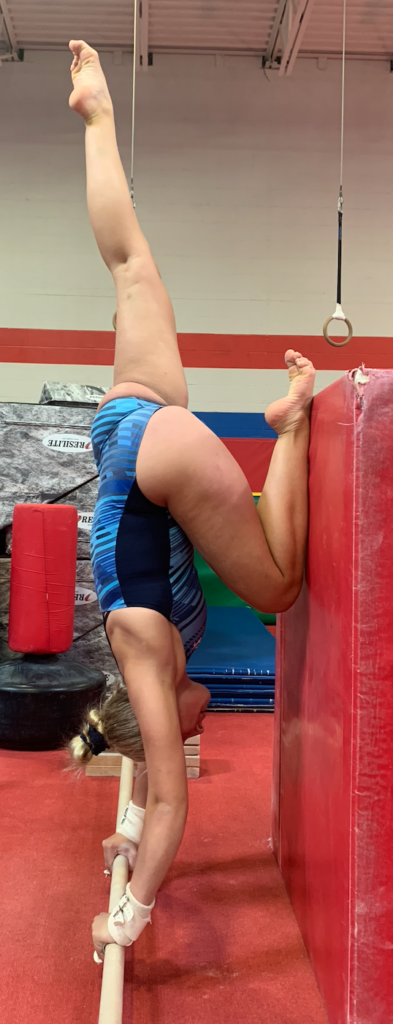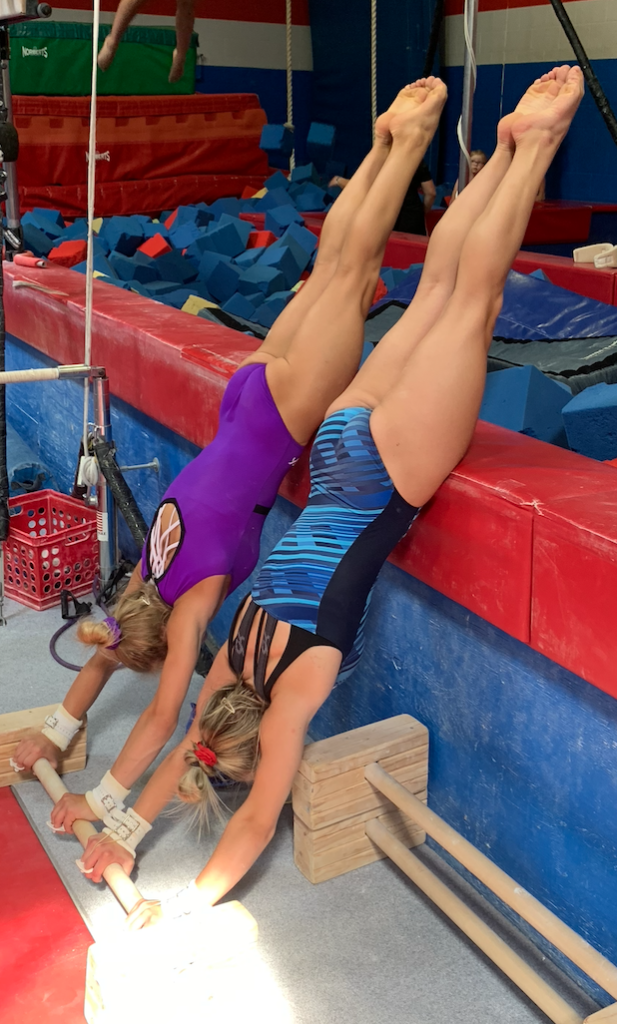
The 4 basics of uneven bars are the root of our entire uneven bars gymnastics system. This starts at the youngest of team levels building the foundation for a strong future in optional or elite gymnastics. Every workout, every day, is based on the 4 basics of uneven bars and is continually emphasized at all levels. The athletes stay with working these 4 basics and only advance how they perform their basics. As the athletes get more efficient with their basics, they will continue to sequence them into complexes and work them throughout their entire gymnastics’ careers.
#1 – Glide Kip Cast Handstand
The 1st basic to women’s uneven bars in the glide kip cast handstand. Yes, we include the glide kip and cast handstand into 1 basic element. Our bar theory is based on the premise that all skills on bars start and end in a handstand (not ALL, but a lot!). We teach both the straight and straddle cast handstand. This includes advancing this category of kip drills to under-grip run through kips, under-grip straddle cast handstands, etc…

#2 – 2 Different In-Bar Circles to Handstand
Our 2nd basic to uneven bars are the in-bar circles. We let our athletes choose which 2 circles they would like to learn of the 3 backward circles listed below. Once they choose 2, they now have had the opportunity to choose their own gymnastics skills and work to master them. On special occasions some athletes will perform all 3 circles. However, for your average 20 hour a week level 10 athlete 2 circles are perfect for long-term success on bars!
Clear Hip Handstand
Many kids choose this skill since it is the first circle introduced and competed in the USA Gymnastics compulsory program. This is the hardest circle of the 3 circles since the center of gravity is the closest to the bar. (Coaches note: There is less room for error on future optional skills).
Toe Circle Handstand
The late drop toe circle handstand is by far the easiest of the 3 circles to learn. The athletes center of gravity is the farthest away from the bar throughout the circle. (More room for error to still complete future skills). The late toe drop concept may take some time for athletes to master but the toe shoot to handstand is much easier for athletes than the clear hip handstand. Think about how much shorter the path to handstand is for the center of gravity (hips) on a toe circle handstand versus and clear hip handstand.
Rear Stalder Handstand
This circle has a few more prerequisites than the clear hip handstand and toe circle handstand; press handstand strength, hip flexibility/mobility, etc. When a rear stalder is done well it is in my opinion the most beautiful skill on women’s uneven bars. It flows!!! This skill sometimes has to be discontinued with athletes as they age due to the force at the bottom of the skill which can cause pressure on the lumbar spine.
Other Circles
We will get into Weilers, inside stalders and other in-bar circles in other blog posts. We are sticking to the 4 basics of uneven bars today!
#3 – Long Swing – Back and Front Giants
The 3rd basic to uneven bars includes both the front and back giant. Yes, both of these need to be mastered for long term uneven bar success.
Back Giants
When we talk back giants we are also talking about the breakdown of the skill, the tap swing. All of this needs to be mastered, with perfect form. The tap swing needs to be over-exaggerated as we usually lose a portion of the swing during real skills. You can see Drills for the Back Giant on Bars here.

Front Giants
This concept might start a debate but it has worked in our system for many years leading to double front dismounts and lots of jaegers. We teach the “mens style” rollover front giant first immediately switching it to a straddle front giant. Then we teach the “whip tap” front giant. The front giant is taught in a short amount of time, a few days to a few weeks. The reason it’s a fast skill to learn is that when we start the process of teaching the front giant to the athlete they have done under-grip work on bars for 2 years already getting physically prepared.
#4 – Layout Dismount – Back and Front Layout
4th and final basics to bars, the back and front layout flyaways. These need to be performed from all types of swings, tap swings, casts, cast handstand and giants.
Back Layout Dismount
The back layout flyaway needs to be performed and mastered from 4 different phases: back layout dismount performed from tap swings, from a small horizontal hollow cast, from a cast handstand and from giants.
Front Layout Dismount
Similar to the back layout dismount the front layout needs to be performed and mastered from 3 different phases: the front giant “whip tap” swing, from a cast over, from a cast handstand and from front giants.
Final thoughts on the 4 basics to uneven bars
Add the 4 basics to your athletes daily workouts, whether it’s 10 minutes for bar warm-up or an entire bar station/rotation dedicated to the 4 uneven bar basics! We personally spend 8-12 minutes a day out of 45 minutes a day on bar basics or conditioning. Also in between every turn on bars is another bar basic drill on a floor bar. All of the optional level skills are based on the 4 basics to bars.
The cleaner and more consistent the bar basics the better the optional skills will become.
Other events from How To Gymnastics:
Warning: The reader of this article should exercise all precautions before following any of the exercises from this article and website. To avoid any problems while doing the exercises, it is advised that you consult a medical professional and are supervised by a gymnastics professional. The responsibility lies solely with the reader and not with the site or the writers.
This post may contain affiliate links meaning if you buy something we get a small commission at no extra cost to you.